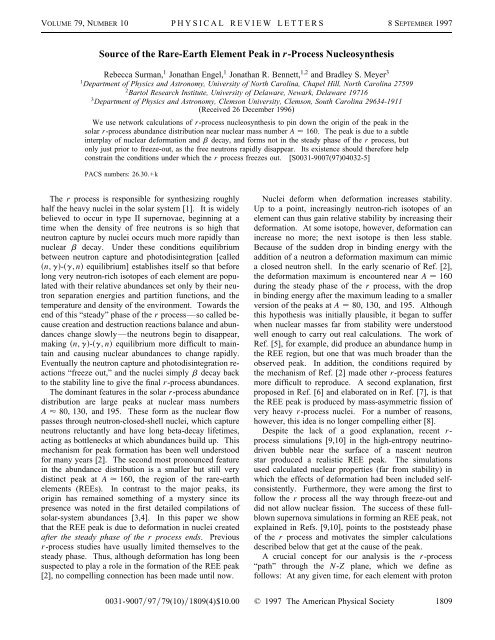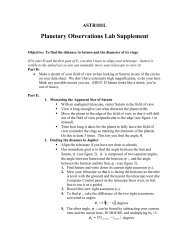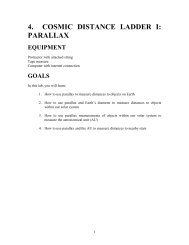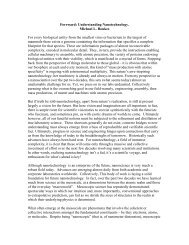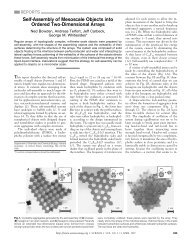Source of the Rare-Earth Element Peak in r-Process Nucleosynthesis
Source of the Rare-Earth Element Peak in r-Process Nucleosynthesis
Source of the Rare-Earth Element Peak in r-Process Nucleosynthesis
You also want an ePaper? Increase the reach of your titles
YUMPU automatically turns print PDFs into web optimized ePapers that Google loves.
VOLUME 79, NUMBER 10 PHYSICAL REVIEW LETTERS 8SEPTEMBER 1997<br />
<strong>Source</strong> <strong>of</strong> <strong>the</strong> <strong>Rare</strong>-<strong>Earth</strong> <strong>Element</strong> <strong>Peak</strong> <strong>in</strong> r-<strong>Process</strong> Nucleosyn<strong>the</strong>sis<br />
Rebecca Surman, 1 Jonathan Engel, 1 Jonathan R. Bennett, 1,2 and Bradley S. Meyer 3<br />
1 Department <strong>of</strong> Physics and Astronomy, University <strong>of</strong> North Carol<strong>in</strong>a, Chapel Hill, North Carol<strong>in</strong>a 27599<br />
2 Bartol Research Institute, University <strong>of</strong> Delaware, Newark, Delaware 19716<br />
3 Department <strong>of</strong> Physics and Astronomy, Clemson University, Clemson, South Carol<strong>in</strong>a 29634-1911<br />
(Received 26 December 1996)<br />
We use network calculations <strong>of</strong> r-process nucleosyn<strong>the</strong>sis to p<strong>in</strong> down <strong>the</strong> orig<strong>in</strong> <strong>of</strong> <strong>the</strong> peak <strong>in</strong> <strong>the</strong><br />
solar r-process abundance distribution near nuclear mass number A 160. The peak is due to a subtle<br />
<strong>in</strong>terplay <strong>of</strong> nuclear deformation and b decay, and forms not <strong>in</strong> <strong>the</strong> steady phase <strong>of</strong> <strong>the</strong> r process, but<br />
only just prior to freeze-out, as <strong>the</strong> free neutrons rapidly disappear. Its existence should <strong>the</strong>refore help<br />
constra<strong>in</strong> <strong>the</strong> conditions under which <strong>the</strong> r process freezes out. [S0031-9007(97)04032-5]<br />
PACS numbers: 26.30.+k<br />
The r process is responsible for syn<strong>the</strong>siz<strong>in</strong>g roughly<br />
half <strong>the</strong> heavy nuclei <strong>in</strong> <strong>the</strong> solar system [1]. It is widely<br />
believed to occur <strong>in</strong> type II supernovae, beg<strong>in</strong>n<strong>in</strong>g at a<br />
time when <strong>the</strong> density <strong>of</strong> free neutrons is so high that<br />
neutron capture by nuclei occurs much more rapidly than<br />
nuclear b decay. Under <strong>the</strong>se conditions equilibrium<br />
between neutron capture and photodis<strong>in</strong>tegration [called<br />
n, g-g, n equilibrium] establishes itself so that before<br />
long very neutron-rich isotopes <strong>of</strong> each element are populated<br />
with <strong>the</strong>ir relative abundances set only by <strong>the</strong>ir neutron<br />
separation energies and partition functions, and <strong>the</strong><br />
temperature and density <strong>of</strong> <strong>the</strong> environment. Towards <strong>the</strong><br />
end <strong>of</strong> this “steady” phase <strong>of</strong> <strong>the</strong> r process—so called because<br />
creation and destruction reactions balance and abundances<br />
change slowly—<strong>the</strong> neutrons beg<strong>in</strong> to disappear,<br />
mak<strong>in</strong>g n, g-g, n equilibrium more difficult to ma<strong>in</strong>ta<strong>in</strong><br />
and caus<strong>in</strong>g nuclear abundances to change rapidly.<br />
Eventually <strong>the</strong> neutron capture and photodis<strong>in</strong>tegration reactions<br />
“freeze out,” and <strong>the</strong> nuclei simply b decay back<br />
to <strong>the</strong> stability l<strong>in</strong>e to give <strong>the</strong> f<strong>in</strong>al r-process abundances.<br />
The dom<strong>in</strong>ant features <strong>in</strong> <strong>the</strong> solar r-process abundance<br />
distribution are large peaks at nuclear mass numbers<br />
A 80, 130, and 195. These form as <strong>the</strong> nuclear flow<br />
passes through neutron-closed-shell nuclei, which capture<br />
neutrons reluctantly and have long beta-decay lifetimes,<br />
act<strong>in</strong>g as bottlenecks at which abundances build up. This<br />
mechanism for peak formation has been well understood<br />
for many years [2]. The second most pronounced feature<br />
<strong>in</strong> <strong>the</strong> abundance distribution is a smaller but still very<br />
dist<strong>in</strong>ct peak at A 160, <strong>the</strong> region <strong>of</strong> <strong>the</strong> rare-earth<br />
elements (REEs). In contrast to <strong>the</strong> major peaks, its<br />
orig<strong>in</strong> has rema<strong>in</strong>ed someth<strong>in</strong>g <strong>of</strong> a mystery s<strong>in</strong>ce its<br />
presence was noted <strong>in</strong> <strong>the</strong> first detailed compilations <strong>of</strong><br />
solar-system abundances [3,4]. In this paper we show<br />
that <strong>the</strong> REE peak is due to deformation <strong>in</strong> nuclei created<br />
after <strong>the</strong> steady phase <strong>of</strong> <strong>the</strong> r process ends. Previous<br />
r-process studies have usually limited <strong>the</strong>mselves to <strong>the</strong><br />
steady phase. Thus, although deformation has long been<br />
suspected to play a role <strong>in</strong> <strong>the</strong> formation <strong>of</strong> <strong>the</strong> REE peak<br />
[2], no compell<strong>in</strong>g connection has been made until now.<br />
Nuclei deform when deformation <strong>in</strong>creases stability.<br />
Up to a po<strong>in</strong>t, <strong>in</strong>creas<strong>in</strong>gly neutron-rich isotopes <strong>of</strong> an<br />
element can thus ga<strong>in</strong> relative stability by <strong>in</strong>creas<strong>in</strong>g <strong>the</strong>ir<br />
deformation. At some isotope, however, deformation can<br />
<strong>in</strong>crease no more; <strong>the</strong> next isotope is <strong>the</strong>n less stable.<br />
Because <strong>of</strong> <strong>the</strong> sudden drop <strong>in</strong> b<strong>in</strong>d<strong>in</strong>g energy with <strong>the</strong><br />
addition <strong>of</strong> a neutron a deformation maximum can mimic<br />
a closed neutron shell. In <strong>the</strong> early scenario <strong>of</strong> Ref. [2],<br />
<strong>the</strong> deformation maximum is encountered near A 160<br />
dur<strong>in</strong>g <strong>the</strong> steady phase <strong>of</strong> <strong>the</strong> r process, with <strong>the</strong> drop<br />
<strong>in</strong> b<strong>in</strong>d<strong>in</strong>g energy after <strong>the</strong> maximum lead<strong>in</strong>g to a smaller<br />
version <strong>of</strong> <strong>the</strong> peaks at A 80, 130, and 195. Although<br />
this hypo<strong>the</strong>sis was <strong>in</strong>itially plausible, it began to suffer<br />
when nuclear masses far from stability were understood<br />
well enough to carry out real calculations. The work <strong>of</strong><br />
Ref. [5], for example, did produce an abundance hump <strong>in</strong><br />
<strong>the</strong> REE region, but one that was much broader than <strong>the</strong><br />
observed peak. In addition, <strong>the</strong> conditions required by<br />
<strong>the</strong> mechanism <strong>of</strong> Ref. [2] made o<strong>the</strong>r r-process features<br />
more difficult to reproduce. A second explanation, first<br />
proposed <strong>in</strong> Ref. [6] and elaborated on <strong>in</strong> Ref. [7], is that<br />
<strong>the</strong> REE peak is produced by mass-asymmetric fission <strong>of</strong><br />
very heavy r-process nuclei. For a number <strong>of</strong> reasons,<br />
however, this idea is no longer compell<strong>in</strong>g ei<strong>the</strong>r [8].<br />
Despite <strong>the</strong> lack <strong>of</strong> a good explanation, recent r-<br />
process simulations [9,10] <strong>in</strong> <strong>the</strong> high-entropy neutr<strong>in</strong>odriven<br />
bubble near <strong>the</strong> surface <strong>of</strong> a nascent neutron<br />
star produced a realistic REE peak. The simulations<br />
used calculated nuclear properties (far from stability) <strong>in</strong><br />
which <strong>the</strong> effects <strong>of</strong> deformation had been <strong>in</strong>cluded selfconsistently.<br />
Fur<strong>the</strong>rmore, <strong>the</strong>y were among <strong>the</strong> first to<br />
follow <strong>the</strong> r process all <strong>the</strong> way through freeze-out and<br />
did not allow nuclear fission. The success <strong>of</strong> <strong>the</strong>se fullblown<br />
supernova simulations <strong>in</strong> form<strong>in</strong>g an REE peak, not<br />
expla<strong>in</strong>ed <strong>in</strong> Refs. [9,10], po<strong>in</strong>ts to <strong>the</strong> poststeady phase<br />
<strong>of</strong> <strong>the</strong> r process and motivates <strong>the</strong> simpler calculations<br />
described below that get at <strong>the</strong> cause <strong>of</strong> <strong>the</strong> peak.<br />
A crucial concept for our analysis is <strong>the</strong> r-process<br />
“path” through <strong>the</strong> N-Z plane, which we def<strong>in</strong>e as<br />
follows: At any given time, for each element with proton<br />
0031-90079779(10)1809(4)$10.00 © 1997 The American Physical Society 1809
VOLUME 79, NUMBER 10 PHYSICAL REVIEW LETTERS 8SEPTEMBER 1997<br />
number Z, <strong>the</strong>re is an isotope with maximum abundance;<br />
<strong>the</strong> collection <strong>of</strong> all such isotopes def<strong>in</strong>es <strong>the</strong> path at<br />
that time. As long as b-decay rates are much less than<br />
neutron-capture or dis<strong>in</strong>tegration rates and <strong>the</strong> system is <strong>in</strong><br />
n, g-g, n equilibrium, <strong>the</strong> path’s location follows from<br />
<strong>the</strong> requirement that <strong>the</strong> average free energy be stationary<br />
under <strong>the</strong> transfer <strong>of</strong> a neutron from a nucleus to <strong>the</strong> freeneutron<br />
bath. This <strong>in</strong> turn means roughly that for every<br />
Z <strong>the</strong> isotope with maximum abundance has a neutron<br />
separation <strong>of</strong><br />
( √ !<br />
rN A Y n 2p ¯h 2 32<br />
)<br />
S n Z, N max 2kT ln<br />
, (1)<br />
2 m n kT<br />
where N max is <strong>the</strong> neutron number <strong>of</strong> <strong>the</strong> isotope, T is<br />
<strong>the</strong> temperature, r is <strong>the</strong> mass density, N A is Avagadro’s<br />
number, Y n is <strong>the</strong> abundance <strong>of</strong> free neutrons per nucleon,<br />
and m n is <strong>the</strong> neutron’s mass. Equation (1) shows that<br />
for given T, r, and Y n , <strong>the</strong> equilibrium path always lies<br />
along a contour <strong>of</strong> constant separation energy.<br />
The high-entropy r-process calculations <strong>of</strong> Refs. [9,10]<br />
alluded to above were performed with<strong>in</strong> <strong>the</strong> context <strong>of</strong> detailed<br />
supernova simulations. To get a clear picture <strong>of</strong><br />
<strong>the</strong> dynamics <strong>of</strong> <strong>the</strong> r-process path, here we simply parametrize<br />
<strong>the</strong> dependence <strong>of</strong> temperature on time (with<br />
r~T 3 and assum<strong>in</strong>g a simple constant outflow velocity<br />
[11]) to roughly match <strong>the</strong> results <strong>of</strong> <strong>the</strong> more complicated<br />
calculations. We <strong>the</strong>n solve <strong>the</strong> network differential<br />
equations (described <strong>in</strong> Ref. [1]) that determ<strong>in</strong>e <strong>the</strong> time<br />
development <strong>of</strong> nucleosyn<strong>the</strong>sis. The <strong>in</strong>puts, besides <strong>the</strong><br />
temperature and density, are <strong>the</strong> <strong>in</strong>itial mass fractions <strong>of</strong><br />
neutrons and preexist<strong>in</strong>g “seed” nuclei, and calculated neutron<br />
capture rates [1], neutron separation energies [12], and<br />
b-decay rates [12]. The seed nuclei quickly come <strong>in</strong>to<br />
n, g-g, n equilibrium and <strong>the</strong>n undergo <strong>the</strong> usual b-<br />
decay and neutron-capture sequence. We run <strong>the</strong> simulations<br />
through freeze-out until only stable nuclei rema<strong>in</strong>.<br />
The treatment is fully dynamical <strong>in</strong> that neutron capture<br />
and photodis<strong>in</strong>tegration cont<strong>in</strong>ue to compete with b decay<br />
throughout <strong>the</strong> entire process, even when equilibrium<br />
no longer obta<strong>in</strong>s. In <strong>the</strong> more detailed supernova<br />
simulations, <strong>the</strong> high-entropy r process occurs over several<br />
seconds, and many r-process components comb<strong>in</strong>e<br />
to give <strong>the</strong> f<strong>in</strong>al abundance distribution (see, e.g., Fig. 15<br />
<strong>of</strong> Ref. [10]). The calculations presented here treat just<br />
<strong>the</strong> components with <strong>the</strong> highest <strong>in</strong>itial neutronseed nucleus<br />
ratios, because <strong>the</strong>y are responsible for <strong>the</strong> REE peak.<br />
These components are also responsible for <strong>the</strong> large peak<br />
at A 195 <strong>in</strong> <strong>the</strong> more detailed simulations. In fact, no<br />
matter what <strong>the</strong> precise conditions <strong>in</strong> <strong>the</strong> supernova, virtually<br />
any high-entropy r-process component that produces<br />
<strong>the</strong> A 195 peak with sufficient abundance and <strong>in</strong> <strong>the</strong> correct<br />
location also makes a REE peak [11] if freeze-out is<br />
treated dynamically.<br />
A sample set <strong>of</strong> r-process abundances result<strong>in</strong>g from<br />
our calculations appear <strong>in</strong> Fig. 1(a) alongside <strong>the</strong> measured<br />
solar-system abundances. In this run <strong>the</strong> <strong>in</strong>itial seed<br />
nucleus was 70 Fe and <strong>the</strong> <strong>in</strong>itial value <strong>of</strong> R, <strong>the</strong> ratio<br />
1810<br />
FIG. 1. Calculated (l<strong>in</strong>e) and measured (crosses) solar r-<br />
process abundances. (a) shows <strong>the</strong> f<strong>in</strong>al calculated abundances<br />
and (b) <strong>the</strong> calculated abundances before freeze-out, while <strong>the</strong><br />
r process is <strong>in</strong> <strong>the</strong> steady phase.<br />
<strong>of</strong> <strong>the</strong> abundance <strong>of</strong> free nucleons to that <strong>of</strong> nuclei was<br />
57, imply<strong>in</strong>g that a seed captured on average 57 neutrons<br />
over <strong>the</strong> duration <strong>of</strong> <strong>the</strong> r process. The trough <strong>in</strong> <strong>the</strong> calculations<br />
just above <strong>the</strong> peak at N 82 (A 130) can<br />
be largely filled <strong>in</strong> by ano<strong>the</strong>r component with slightly<br />
different temperature and neutron density. What is important<br />
is <strong>the</strong> presence <strong>of</strong> a REE peak at approximately<br />
<strong>the</strong> correct location and with <strong>the</strong> correct width. No sign<br />
<strong>of</strong> this peak exists dur<strong>in</strong>g <strong>the</strong> steady phase <strong>of</strong> <strong>the</strong> r<br />
process [Fig. 1(b)]. It forms only after R falls below<br />
about 1, when steady b flow is destroyed and <strong>the</strong> path<br />
beg<strong>in</strong>s to move towards stability. The peak appears under<br />
a wide range <strong>of</strong> <strong>in</strong>itial temperatures, densities, and<br />
neutronseed ratios, as well as changes by factors <strong>of</strong> 5<br />
or more <strong>in</strong> all calculated b-decay rates, provided only<br />
that freeze-out is prompted by <strong>the</strong> capture <strong>of</strong> nearly all<br />
free neutrons ra<strong>the</strong>r than a sudden drop <strong>in</strong> overall density<br />
and temperature, as is sometimes assumed. The primary<br />
reason, surpris<strong>in</strong>gly, is that if <strong>the</strong> temperature and<br />
density do not change precipitously <strong>the</strong> r process stays<br />
<strong>in</strong> approximate n, g-g, n equilibrium even after steady<br />
flow fails. Only when R has fallen by many orders <strong>of</strong><br />
magnitude does b decay completely dom<strong>in</strong>ate <strong>the</strong> o<strong>the</strong>r<br />
reactions and destroy <strong>the</strong> remnants <strong>of</strong> n, g-g, n equilibrium.<br />
As a result, <strong>the</strong> path cont<strong>in</strong>ues for some time<br />
to lie roughly along contours <strong>of</strong> constant neutron separation<br />
energy as it moves towards stability. It is dur<strong>in</strong>g<br />
this time that <strong>the</strong> REE peak forms.<br />
Figure 2 illustrates <strong>the</strong> persistence <strong>of</strong> approximate<br />
n, g-g, n equilibrium; it shows <strong>the</strong> path between<br />
N 82 and 126 at three times dur<strong>in</strong>g a 0.25-sec <strong>in</strong>terval<br />
just after <strong>the</strong> steady phase ends. Dur<strong>in</strong>g this period, as<br />
<strong>in</strong>dicated by <strong>the</strong> <strong>in</strong>set <strong>of</strong> Fig. 2, R (or Y n ) drops dramatically<br />
(<strong>the</strong> diamonds mark <strong>the</strong> three times at which <strong>the</strong>
VOLUME 79, NUMBER 10 PHYSICAL REVIEW LETTERS 8SEPTEMBER 1997<br />
FIG. 2. The r-process path between N 82 and 126 at three<br />
times dur<strong>in</strong>g a 0.25-sec <strong>in</strong>terval early <strong>in</strong> <strong>the</strong> decay to stability.<br />
The shaded squares are <strong>the</strong> actual paths, <strong>the</strong> lightest correspond<strong>in</strong>g<br />
to <strong>the</strong> latest time, and <strong>the</strong> diamonds <strong>the</strong> equilibrium paths<br />
def<strong>in</strong>ed at <strong>the</strong> same times by Eq. (1). The l<strong>in</strong>es are contours <strong>of</strong><br />
constant separation energy <strong>in</strong> MeV. The <strong>in</strong>set shows <strong>the</strong> neutron<br />
abundance per nucleon over this <strong>in</strong>terval, with <strong>the</strong> three<br />
times at which <strong>the</strong> path is depicted <strong>in</strong>dicated by diamonds.<br />
path is plotted), while T and r change slowly, with <strong>the</strong><br />
net result accord<strong>in</strong>g to Eq. (1) that <strong>the</strong> path moves back<br />
towards more stable nuclei with higher neutron separation<br />
energies. The dark squares <strong>in</strong> <strong>the</strong> large figure are <strong>the</strong><br />
paths as def<strong>in</strong>ed above, with <strong>the</strong> upper set correspond<strong>in</strong>g<br />
to <strong>the</strong> later time. The open diamonds <strong>in</strong>dicate <strong>the</strong><br />
“equilibrium paths,” i.e., those that would obta<strong>in</strong> if <strong>the</strong><br />
system were <strong>in</strong> true n, g-g, n equilibrium accord<strong>in</strong>g to<br />
Eq. (1). Contours <strong>of</strong> constant neutron separation energy<br />
for <strong>the</strong> even N nuclei are overlaid. The actual and<br />
equilibrium paths <strong>in</strong>deed differ very little well after <strong>the</strong><br />
end <strong>of</strong> <strong>the</strong> steady phase. Eventually (and importantly), as<br />
<strong>the</strong> figure shows, a “k<strong>in</strong>k” <strong>in</strong> <strong>the</strong> separation energies at<br />
N 104 is <strong>in</strong>tercepted and imposes itself on <strong>the</strong> path.<br />
Large k<strong>in</strong>ks <strong>in</strong> <strong>the</strong> path are <strong>the</strong> underly<strong>in</strong>g cause<br />
<strong>of</strong> <strong>the</strong> abundance peaks at <strong>the</strong> neutron closed shells<br />
mentioned above. Because <strong>the</strong> neutrons <strong>in</strong> all <strong>the</strong>se nuclei<br />
are strongly bound <strong>the</strong> path turns sharply up towards<br />
stability when a closed shell is reached, produc<strong>in</strong>g a<br />
concentration <strong>of</strong> populated isotopes close toge<strong>the</strong>r <strong>in</strong> A<br />
with relatively long b-decay lifetimes. The early steadyphase<br />
explanation <strong>of</strong> <strong>the</strong> REE peak <strong>in</strong> Ref. [2] is a<br />
variation on <strong>the</strong> same <strong>the</strong>me. In our simulations, however,<br />
<strong>the</strong> REE peak does not form <strong>in</strong> exactly this way, even<br />
though it is clearly associated with <strong>the</strong> N 104 k<strong>in</strong>k,<br />
which <strong>in</strong> turn is clearly due [12] to <strong>the</strong> deformation<br />
maximum postulated <strong>in</strong> Ref. [2]. The nuclei at <strong>the</strong><br />
top <strong>of</strong> <strong>the</strong> k<strong>in</strong>k, and thus closer to stability, do have<br />
moderately slower b-decay rates than those along <strong>the</strong><br />
path immediately below, but nei<strong>the</strong>r this fact nor <strong>the</strong><br />
proximity <strong>of</strong> <strong>the</strong> k<strong>in</strong>k nuclei to one ano<strong>the</strong>r along <strong>the</strong> path<br />
account entirely for <strong>the</strong> pronounced REE peak. Ano<strong>the</strong>r<br />
mechanism, rely<strong>in</strong>g on <strong>the</strong> motion <strong>of</strong> <strong>the</strong> path towards<br />
stability after <strong>the</strong> failure <strong>of</strong> steady flow, is also at work.<br />
FIG. 3. Contours <strong>of</strong> constant neutron separation energy <strong>in</strong><br />
MeV (solid l<strong>in</strong>es) and constant b-decay rates <strong>in</strong> s 21 (dashed<br />
l<strong>in</strong>es). The <strong>in</strong>set is a schematic <strong>of</strong> two such contours, with <strong>the</strong><br />
arrows depict<strong>in</strong>g <strong>the</strong> flow <strong>of</strong> nuclei <strong>in</strong>to <strong>the</strong> region conta<strong>in</strong><strong>in</strong>g<br />
<strong>the</strong> separation-energy k<strong>in</strong>k.<br />
Once steady flow ceases, Y n falls rapidly compared<br />
to <strong>the</strong> rate <strong>of</strong> decl<strong>in</strong>e <strong>in</strong> temperature and density. By<br />
Eq. (1) <strong>the</strong>n, <strong>the</strong> path moves quickly towards stability at a<br />
rate governed by <strong>the</strong> average b-decay lifetime for nuclei<br />
ly<strong>in</strong>g on <strong>the</strong> path. Dur<strong>in</strong>g <strong>the</strong> <strong>in</strong>terval when <strong>the</strong> path runs<br />
through <strong>the</strong> k<strong>in</strong>k, this average rate is typically <strong>the</strong> rate <strong>of</strong> a<br />
nucleus <strong>in</strong> <strong>the</strong> k<strong>in</strong>k itself. Below <strong>the</strong> k<strong>in</strong>k, as illustrated <strong>in</strong><br />
<strong>the</strong> center <strong>of</strong> Fig. 3, <strong>the</strong> nuclei along <strong>the</strong> path are far<strong>the</strong>r<br />
from stability and <strong>the</strong>refore decay faster than average,<br />
i.e., before <strong>the</strong> average separation energy has changed<br />
enough to move <strong>the</strong> equilibrium path <strong>in</strong> <strong>the</strong>ir vic<strong>in</strong>ity. In<br />
an attempt to return to <strong>the</strong> path and stay <strong>in</strong> equilibrium,<br />
<strong>the</strong>se nuclei <strong>the</strong>n capture neutrons, <strong>in</strong>creas<strong>in</strong>g <strong>the</strong>ir value<br />
<strong>of</strong> A. The nuclei above <strong>the</strong> k<strong>in</strong>k, by contrast, decay more<br />
slowly than average, and <strong>in</strong> general will not do so before<br />
<strong>the</strong> equilibrium path at <strong>the</strong>ir location has moved. When it<br />
does move, <strong>the</strong>se nuclei, whose <strong>the</strong>rmodynamic impetus<br />
is also to rema<strong>in</strong> <strong>in</strong> equilibrium at <strong>the</strong> average separation<br />
energy, photodis<strong>in</strong>tegrate so that <strong>the</strong>ir mass number A is<br />
lowered. In fact, it is <strong>the</strong>se dis<strong>in</strong>tegrat<strong>in</strong>g nuclei above<br />
<strong>the</strong> k<strong>in</strong>k that supply <strong>in</strong> part <strong>the</strong> neutrons for capture by<br />
b-decay<strong>in</strong>g nuclei below <strong>the</strong> k<strong>in</strong>k. The net result, shown<br />
with arrows <strong>in</strong> <strong>the</strong> <strong>in</strong>set <strong>in</strong> Fig. 3, is a funnel<strong>in</strong>g <strong>of</strong> nuclei<br />
<strong>in</strong>to <strong>the</strong> k<strong>in</strong>k region as <strong>the</strong> path moves toward stability.<br />
To show that this mechanism is both simple and robust,<br />
we ran a simulation with our own simplified and easily<br />
varied nuclear properties. We obta<strong>in</strong>ed b<strong>in</strong>d<strong>in</strong>g energies<br />
from a simple semiempirical mass formula ([13]) and b-<br />
decay lifetimes by fitt<strong>in</strong>g those <strong>of</strong> Ref. [12] with a function<br />
<strong>of</strong> <strong>the</strong> form T 12 aQ a , where Q is <strong>the</strong> difference<br />
<strong>in</strong> b<strong>in</strong>d<strong>in</strong>g energies between <strong>the</strong> parent and daughter and<br />
<strong>the</strong> best fit was obta<strong>in</strong>ed with a 250 and a 23.80.<br />
We assumed neutron capture rates, <strong>the</strong> details <strong>of</strong> which<br />
are irrelevant, to have an exponential dependence on separation<br />
energy, reflect<strong>in</strong>g <strong>the</strong>ir dependence on <strong>the</strong> level<br />
density <strong>in</strong> <strong>the</strong> compound nucleus formed by capture. We<br />
started <strong>the</strong> simulation at <strong>the</strong> end <strong>of</strong> <strong>the</strong> steady phase <strong>of</strong><br />
1811
VOLUME 79, NUMBER 10 PHYSICAL REVIEW LETTERS 8SEPTEMBER 1997<br />
FIG. 4. Abundances on a l<strong>in</strong>ear scale near A 160 <strong>in</strong> <strong>the</strong><br />
simplified model (see text). (a) is with smooth separationenergy<br />
contours, (b) with a k<strong>in</strong>k <strong>in</strong> <strong>the</strong> contours, and (c) with<br />
constant b-decay rates along each k<strong>in</strong>ked contour. The crosses<br />
are <strong>the</strong> appropriately scaled solar abundances.<br />
<strong>the</strong> r process, with abundances along <strong>the</strong> equilibrium path<br />
between N 82 and N 126 taken to be identically<br />
normalized Gaussian curves <strong>of</strong> width 1.05 centered for<br />
each Z at <strong>the</strong> values <strong>of</strong> N max produced by our more realistic<br />
model. These conditions produced a flat f<strong>in</strong>al<br />
abundance curve, shown <strong>in</strong> Fig. 4(a) alongside <strong>the</strong><br />
(appropriately scaled) solar abundances. When we <strong>in</strong>troduced<br />
a k<strong>in</strong>k <strong>in</strong>to <strong>the</strong> separation energies at N 104,<br />
adjust<strong>in</strong>g <strong>the</strong> capture and b-decay rates to reflect <strong>the</strong><br />
new b<strong>in</strong>d<strong>in</strong>gs, a REE peak match<strong>in</strong>g that <strong>in</strong> <strong>the</strong> solarabundance<br />
curve formed [Fig. 4(b)]. But when we<br />
modified <strong>the</strong> b-decay rates to be constant along curves<br />
<strong>of</strong> constant separation energy, destroy<strong>in</strong>g <strong>the</strong> b-decay<strong>in</strong>duced<br />
dynamic described above, <strong>the</strong> peak shrank by a<br />
factor <strong>of</strong> about 2 relative to <strong>the</strong> surround<strong>in</strong>g abundance<br />
level [Fig. 4(c)]. This smaller peak <strong>the</strong>refore represents<br />
<strong>the</strong> effects <strong>of</strong> <strong>the</strong> concentration <strong>of</strong> po<strong>in</strong>ts along <strong>the</strong> path<br />
and <strong>the</strong> slight <strong>in</strong>crease <strong>in</strong> b-decay lifetimes at <strong>the</strong> top<br />
<strong>of</strong> <strong>the</strong> k<strong>in</strong>k. These factors alone are clearly not enough<br />
to produce <strong>the</strong> entire REE peak. If, among o<strong>the</strong>r possibilities,<br />
<strong>the</strong> steady r-process path runs through <strong>the</strong> k<strong>in</strong>k,<br />
as postulated <strong>in</strong> Ref. [2], <strong>the</strong> peak will not fully form.<br />
We conclude that although this peak is <strong>in</strong>deed due to a<br />
deformation maximum <strong>in</strong> <strong>the</strong> region, it forms only after<br />
<strong>the</strong> steady phase <strong>of</strong> <strong>the</strong> r process ends.<br />
If our argument is correct, <strong>the</strong> existence <strong>of</strong> <strong>the</strong> peak<br />
has important consequences both for <strong>the</strong> supernova nucleosyn<strong>the</strong>sis<br />
and for <strong>the</strong> nuclear physics <strong>of</strong> neutron-rich<br />
nuclei. First, it means that <strong>the</strong> r-process path must be<br />
mov<strong>in</strong>g back towards stability when freeze-out occurs.<br />
This can happen only if freeze-out is prompted by <strong>the</strong><br />
exhaustion <strong>of</strong> free neutrons. If <strong>the</strong> freeze-out <strong>of</strong> a highentropy<br />
(r ~T 3 )rprocess is <strong>in</strong>stead prompted by a rapid<br />
drop <strong>in</strong> <strong>the</strong> temperature, <strong>the</strong> path will always move away<br />
from stability towards nuclei with very low neutron separation<br />
energy, and no REE peak will form. This fact<br />
argues aga<strong>in</strong>st models <strong>in</strong> which <strong>the</strong> expansion <strong>of</strong> <strong>the</strong> r-<br />
process region is so fast that freeze-out occurs before <strong>the</strong><br />
neutrons have all been captured. Second, regard<strong>in</strong>g nuclear<br />
structure, <strong>the</strong> peak confirms <strong>the</strong> predicted deformation<br />
<strong>of</strong> neutron-rich rare-earth nuclei. We expect future<br />
work on formation <strong>of</strong> <strong>the</strong> REE peak to yield o<strong>the</strong>r important<br />
<strong>in</strong>sights.<br />
The authors are grateful to D. H. Hartmann and D. D.<br />
Clayton for discussions. This work was supported by <strong>the</strong><br />
U.S. Department <strong>of</strong> Energy under Grant No. DE-FG05-<br />
94ER40827 and by NASA under Grant No. NAGW-<br />
3480. We thank <strong>the</strong> Institute for Nuclear Theory at <strong>the</strong><br />
University <strong>of</strong> Wash<strong>in</strong>gton, where some <strong>of</strong> this work was<br />
carried out.<br />
[1] For reviews, see J. J. Cowan, F.-K. Thielemann, and J. W.<br />
Truran, Phys. Rep. 208, 257 (1991); B. S. Meyer, Ann.<br />
Rev. Astron. Astrophys. 32, 153 (1994).<br />
[2] E. M. Burbidge, G. R. Burbidge, W. A. Fowler, and<br />
F. Hoyle, Rev. Mod. Phys. 29, 547 (1957).<br />
[3] H. Brown, Rev. Mod. Phys. 21, 625 (1949).<br />
[4] H. E. Suess and H. C. Urey, Rev. Mod. Phys. 28, 53<br />
(1956).<br />
[5] P. A. Seeger, W. A. Fowler, and D. D. Clayton, Astrophys.<br />
J. 97, 121 (1965).<br />
[6] A. G. W. Cameron, Publ. Astron. Soc. Pac. 69, 201 (1957).<br />
[7] D. N. Schramm and W. A. Fowler, Nature (London) 231,<br />
103 (1971).<br />
[8] K. Marti and H. D. Zeh, Meteoritics 20, No. 2, Pt. 2, 311<br />
(1985).<br />
[9] B. S. Meyer, G. J. Ma<strong>the</strong>ws, W. M. Howard, S. E.<br />
Woosley, and R. H<strong>of</strong>fman, Astrophys. J. 399, 656 (1992).<br />
[10] S. E. Woosley, J. R. Wilson, G. J. Ma<strong>the</strong>ws, R. D. H<strong>of</strong>fman,<br />
and B. S. Meyer, Astrophys. J. 433, 229 (1994).<br />
[11] B. S. Meyer and J. S. Brown, Astrophys. J. Suppl. (to be<br />
published).<br />
[12] P. Moller, J. R. Nix, and K.-L. Kratz (to be published).<br />
[13] See, e.g., A. deShalit and H. Feshbach, Theoretical<br />
Nuclear Physics (Wiley, New York, 1975).<br />
1812


